People
Christopher Scholz Professor, Earth & Environmental Sciences
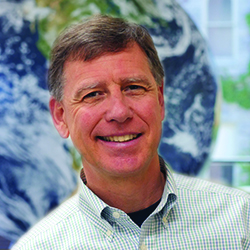 My research focuses on recovering records of past climate from lake basins, and on the sedimentary basin analysis of extensional systems, with emphasis on lacustrine basins. Current research efforts are concentrated on the large lakes of tropical Africa and the Finger Lakes of Central New York. Lake basins contain some of the highest quality archives of climate change on the continents, and new drill core records from the low-latitude lakes of Africa are revealing new details about the Pleistocene record of climate change.
My research focuses on recovering records of past climate from lake basins, and on the sedimentary basin analysis of extensional systems, with emphasis on lacustrine basins. Current research efforts are concentrated on the large lakes of tropical Africa and the Finger Lakes of Central New York. Lake basins contain some of the highest quality archives of climate change on the continents, and new drill core records from the low-latitude lakes of Africa are revealing new details about the Pleistocene record of climate change.
The world’s large rift valley lakes are outstanding laboratories for understanding the interaction of tectonic, climatic, and depositional processes, and are particularly useful for developing models for hydrocarbon exploration in ancient rift systems. These large, deep lakes contain thick accumulations of sediment dating back millions of years, and are among the best places on the continents for reconstructing past climates. Recent field programs have involved scientific drilling in tropical lake basins, the recovery of high-resolution sediment cores from lakes, and the imaging of sedimentary lake basins at various scales, using seismic reflection datasets techniques.
Support for the research comes from the National Science Foundation and a consortium of oil and gas companies.
James Muirhead Research Assistant Professor, Earth & Environmental Sciences
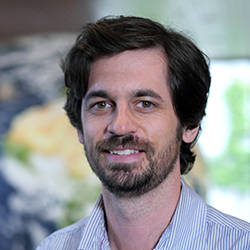 I am interested in interactions between tectonic and volcanic processes. Current work combines classical field geology, remote sensing, and seismic reflection methods to understand local and regional-scale deformation processes in volcano-tectonic systems. Mainly, I enjoy working at any geological setting that contains a fault, dike, fracture or volcano. Recent and ongoing studies focus on:
I am interested in interactions between tectonic and volcanic processes. Current work combines classical field geology, remote sensing, and seismic reflection methods to understand local and regional-scale deformation processes in volcano-tectonic systems. Mainly, I enjoy working at any geological setting that contains a fault, dike, fracture or volcano. Recent and ongoing studies focus on:
Development of fault systems during rift basin evolution in East Africa
The role of magma and magmatic volatiles in driving faulting, strain localization, and continental breakup
Magma emplacement in large igneous provinces
3-D architecture and magma flow within feeder systems to volcanoes
McKenzie Brannon MS Student, Earth & Environmental Sciences
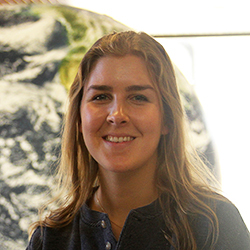
Laura DeMott PhD Candidate, Earth & Environmental Sciences
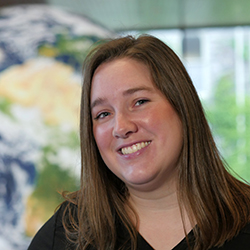 Broadly, I am interested in the sedimentology and geochemistry of non-marine carbonate rocks, and have been involved in research on speleothems, karst spring deposits, hydrothermal spring deposits, and lacustrine deposits. I find carbonates in general to be fascinating because they form from an occasionally complicated interaction between chemical, biological, and physical processes. Because these rocks are formed by precipitating out of water, the chemical composition of the rocks reflects that of the water body they are forming in. Thus, carbonate rocks can potentially be used to reconstruct past conditions of lakes, rivers, springs, groundwater systems, and oceans. This makes them important geologic proxies for understanding the past environments on Earth.
Broadly, I am interested in the sedimentology and geochemistry of non-marine carbonate rocks, and have been involved in research on speleothems, karst spring deposits, hydrothermal spring deposits, and lacustrine deposits. I find carbonates in general to be fascinating because they form from an occasionally complicated interaction between chemical, biological, and physical processes. Because these rocks are formed by precipitating out of water, the chemical composition of the rocks reflects that of the water body they are forming in. Thus, carbonate rocks can potentially be used to reconstruct past conditions of lakes, rivers, springs, groundwater systems, and oceans. This makes them important geologic proxies for understanding the past environments on Earth.
My doctoral research focuses on understanding the processes governing carbonate deposition in rift lakes, focusing on the lake systems of the western Basin and Range. In particular, I am focusing on a type of lacustrine carbonate deposit commonly referred to as “tufa” that is commonly found in the remnant lakes of Pleistocene Lake Lahontan. I am examining the processes that result in tufa carbonate deposition in these lakes at various scales. I use thin section petrography to describe tufas, and employ organic, inorganic, and isotopic geochemistry to examine the conditions in which tufas are deposited. I also use drone technology to map tufa outcrops and create detailed depositional models.
Shaidu Shaban PhD Student, Earth & Environmental Sciences
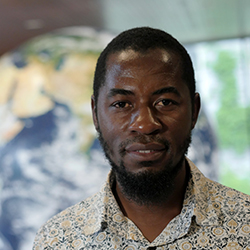
My research focuses on basins evolution, the sedimentary basin analysis of extensional systems, hydrocarbons potential and reconstruction of paleo-environment with emphasis on lacustrine basins. Currently, his research is concentrated on Lake Tanganyika that forms part of the East African Rift Valley, and the Earth’s largest continental rift system that has been proven as oil prone. Accordingly, the lake is an iconic natural laboratory for understanding processes of evolution and how climate and tectonic affected different discharges into the lake.
Laura Streib PhD Student, Earth & Environmental Sciences
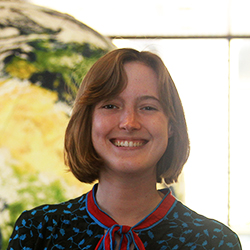
Lachan Wright PhD Student, Earth & Environmental Sciences

Broadly, my research is centred on the structural evolution and crustal kinematics of rift systems, with particular focus on the role that pre-existing structures & climate-tectonic interactions play in rift initiation, rift geometry, strain localization, & sediment routing.
Currently my doctoral research focuses on unravelling the interplay of these factors in the Western Branch of the East African Rift system, focusing on the Lake Tanganyika & Lake Malawi (Nyasa) Rifts through the integration of seismic reflection data, drill cores, refraction velocity models, catchment analysis, & sediment volumes to calculate spatio-temporal trends in extension, slip, and erosion in a young continental rift system. My previous research has focused on the integration of seismic reflection data with deep-time climate simulations to predict the occurrence and distribution of lacustrine source facies within the syn-rift section of ancient rift basins.
Nicholas Zaremba PhD Candidate, Earth & Environmental Sciences
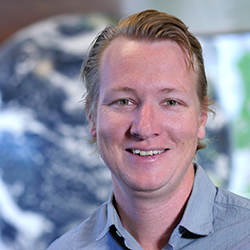
I am interested in studying how climate has changed in the past. I use seismic data in combination with geochemical analyses and modern chronology techniques conducted on sediment cores to better constrain the timing of climate fluctuations recorded in the stratigraphic record.
My doctoral research focuses on the late Pleistocene stratigraphy of Oneida Lake located here in central New York. The aim of the study is to get a better understanding of the timing as well as magnitude of large releases of glacial meltwater into the North Atlantic Ocean. Episodic and catastrophic release of glacial meltwater derived from late Pleistocene proglacial lakes drained into the North Atlantic from a few key drainages, primarily the Mississippi River, St. Lawrence waterway, Hudson River valley and Artic sources. This influx of glacial meltwater into the North Atlantic can affect Atlantic Meridional Overturning Circulation which is responsible for the transport of heat and salinity from the tropics to the northern latitudes. Therefore, a slowdown of the Atlantic Meridional Overturning can have major impacts on climate. In particular it is believed that abrupt climate fluctuations such as the Younger Dryas and Inter-Allerod cold periods were triggered by large influxes of glacial meltwater into the Atlantic Ocean decreasing Atlantic Meridional Overturning Circulation. The focus of my doctoral dissertation will be to constrain the timing and magnitude of meltwater fluxes through the Mohawk Valley, one of the key drainage systems for meltwater to enter the Hudson River valley and then enter the Atlantic Ocean. Drainage through the Mohawk valley possibly played a key role in triggering the Older Dryas, a brief but abrupt cold period occurring ca. 14.3-14 thousand years before present.
I use seismic data in combination with sediments cores to reconstruct paleo environments. For my doctoral research I will use high resolution CHIRP seismic data as well as deeper penetrating multichannel seismic data. Sediment cores will be analyzed for a variety of different chemical and physical parameters including XRF, magnetic susceptibility, stable carbon and nitrogen isotopes, grain-size analyses and radiocarbon age estimates.
Liang Zue Postdoctoral Researcher, Earth & Environmental Sciences

My research work primarily focuses on the coupling between tectonics, climate, and surface processes on seasonal scale and long-term scale (10^3 -10^6 yr), and explore how these three factors link together using numerical models and field observations. Seasonally, annual fluctuation in precipitation, snow, soil moisture, and groundwater could give rise to a considerable stress change in upper crust. I use numerical models to simulate stress build-up, deformation, and seismicity caused by such surface mass loading/unloading. For long-term geologic time scale, I am studying the influence of climate cycle on the crust deformation and fault slip rate. Currently, I am working on the effects of lake water column loading and related changes in pore pressure, and sediment flux on fault behaviors in Malawi Rift.
